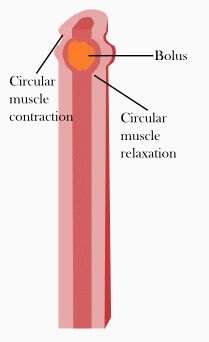The next paper for #microtwjc raises some interesting questions about what effects probiotics have on the gut.
If you want to study the gut, and the bacteria within it, there are a number of little problems. For instance, many of the bacteria in the gut are anaerobes, and will shrivel up the moment they get exposed to air. It is thought that the distribution of different bacteria varies throughout the gut, so just taking faecal samples won't cut it.
So what can you do? There are animal models, where you can try and sample the bacteria in different areas of the intestine after dissection, or perhaps use techniques like
bioluminescence to look at bacteria directly within the digestive tract. I remember hearing someone pitch a project to use magnetic resonance spectroscopy (using some fancy MRI technology) to analyse bacterial metabolites within the guts of human volunteers.
There is another way that researchers can try and work out what's happening in the gut. Through the creation of an artificial gut.
Consider for a second that in simple terms, your gut is basically a fancy bioreactor. It is a vessel in which enzymes, bile and bacteria all get mixed together to help you digest your food. So what if we tried to create this system artificially, and what would reveal about digestion
Minekus et al (published in 1999) developed the system, where they essentially created an artificial model of the large intestine, which over the last ten years has been developed to the one seen in the week 6 #microtwjc paper.
So how does this machine replicate the way that the Large Intestine works ?

- Peristalsis- Your gut moves food around through squeezing it's walls and pushing the food along. The inside of this machine has a series of flexible walled tubes, which have water pumped along the outside of them. The pumping of the water passing through the system causes periodic compressions to be transferred through the system, mirroring the peristaltic movement seen in actual human guts.
- Temperature: The water passing through the gut is heated to body temperature, which is 37
°C.
- Bile: Bile performs a number of functions, such as introducing a number of salts which act to emulsify fats. Another function it performs is neutralising gut acid, and keeping the pH of the large intestine stable. To ensure that the pH of the electric version of this system is stable, pH sensors were present to control the infusion of sodium hydroxide, preventing it from getting too acidic.
- Absorption: The main function of the gut is to absorb nutrients, such as short chain fatty acids. To replicate this, fibre membranes placed at strategic points along the machine allow for small molecules to pass through them. These are hooked up to pumps an pressure sensors to ensure that the pressure within the system remains constant.
- Metabolites: In the human large intestine, partially digested food comes in from the small intestine. To replicate the present of this food, metabolites are added into this system, and because of the way the absorption works (via osmosis) the action of that system also acts to keep the metabolite levels within the gut fairly constant.
- Anaerobic- It is generally thought that the human gut is mostly colonised by anaerobic bacteria*. So air was prevented from entering the system by flushing it with gaseous nitrogen.
This is the basis for the TIM2 system. Now, anyone can easily see that it isn't a perfect model for the gut. With any model, physical or computational, there are limitations. What you get is based off of your assumptions when creating it, and if you forget those, then you can be lead badly astray.
So the question is is it useful?
The only way to determine this is to validate the model.
In the initial paper, they found that the system absorbed short chain fatty acids, and maintained pH fairly well with "standard" fermenter flora and allowed them to survive in the system.
Also "Three successive experiments were carried out using fecal inocula from three diff€erent methane-excreting volunteers". They did not mention whether these people were chosen on the basis of their methane excretion. They looked at how well the faecal flora survived in the large intestine.
So from this first paper, they showed that this model of the gut could keep bacteria from the human gut alive, and that this system could absorb short chain fatty acids.
The point I would like to make about this model system is that yes, it does have limitations. It is not a perfect representation of the human gut. Even though we can't extrapolate findings with this equipment directly into humans, we can still put this machine to good use. It can be use to grow bacteria with different nutrients, and furthermore elucidate some of the more complex relationships between them within the human large intestine.
It is with that in mind that I shall look at the actual #microtwjc paper in part 2 of this post.
Minekus, M., Smeets-Peeters, M., Bernalier, A., Marol-Bonnin, S., Havenaar, R., Marteau, P., Alric, M., Fonty, G. & Huis in't Veld, J.H.J. (1999). A computer-controlled system to simulate conditions of the large intestine with peristaltic mixing, water absorption and absorption of fermentation products, Applied Microbiology and Biotechnology, 53 (1) 114. DOI: 10.1007/s002530051622
Part 2 is up
here
* I should point out right now that I am not entirely certain whether the mammalian gut is entirely an anaerobic environment. For instance, I pointed out a study using bioluminescence to study bacteria as they invaded the gut. The bioluminescence reaction shown there requires oxygen to be present in order to function. So this indicates strongly that there is oxygen in the mammalian gut, but again, this conflicts with what is known about most of the microbiota present, which tend to shrivel and die at the mere mention of that element.


